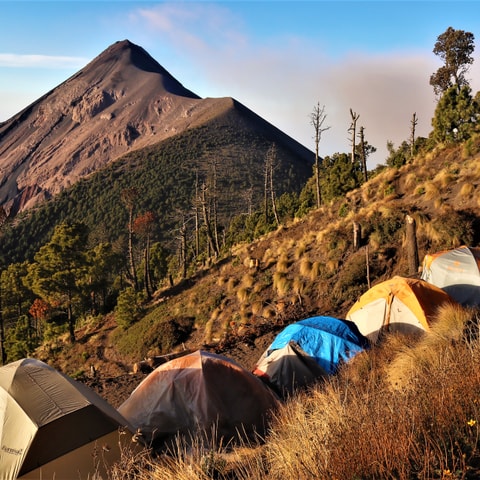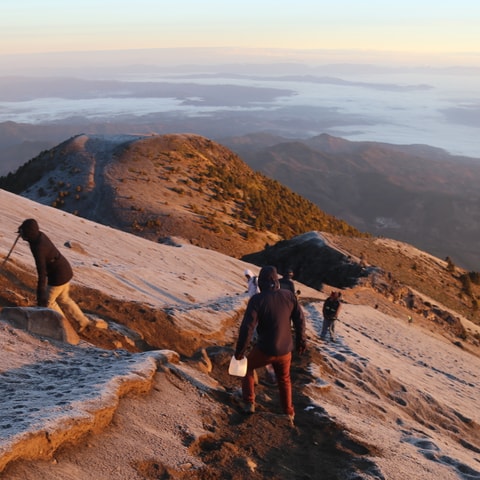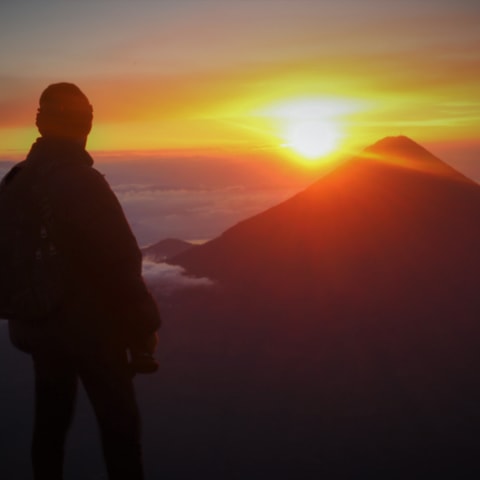Acatenango Volcano: Trekking from Antigua, Guatemala
Summit Acatenango (3,976m) from Antigua, Guatemala for jaw-dropping eruptions from neighboring Fuego—Central America’s most thrilling overnight hike.
By @charlie_nomade - 18/Sep/2025

Duration: 2 days (~5 hours up, ~4 hours down)
Difficulty: Moderate
Landscape: Mountain
Season: Year-round (~8-16 ºC / 46-61 ºF)
About Acatenango & Volcán de Fuego
Acatenango stands at 3,976 meters above sea level and overlooks Antigua, Guatemala. The best part of the trek is Volcán de Fuego: as soon as you reach the Acatenango base camp, where you’ll spend the night, you’ll see it erupting. Fuego is the most active and one of the most impressive volcanoes in Central America. It reaches 3,763 meters and is known for violent eruptions every 15-30 minutes. From the summit, you can also spot Volcán de Agua and, farther away, Volcán Pacaya.

How to Get to the Acatenango Volcano
To hike Acatenango, first head to Antigua, a lovely colonial city about one hour from Guatemala City. From La Aurora International Airport, the best option is a shared shuttle directly to Antigua and it drops you at the central plaza (Plaza de Armas).
It’s not possible to do the ascent on your own; you must book with a tour operator. The price is about 300-400 quetzales (US$35 to US$70). It includes round-trip transport from Antigua to the trailhead, meals, a tent, and warm gear (jacket, gloves, beanie).
You’ll sleep one night at Acatenango camp, start the pre-dawn climb to the summit, and then descend back to Antigua.
Accommodation in Antigua
Antigua has countless places to stay. It’s a colonial city welcoming travelers from around the world. Compared with the average in Latin America, Antigua offers stays of quality at low prices. Some famous hostels are the Three Monkeys - a very pleasant, quiet hostel. Vagamundos - a colorful “hippie hostel”, well located. Doozy Koala and Papagayo - two party hostels, ideal if you want to go out and meet people.

Gear & Supplies to Hike the Acatenango
For this excursion, pack light. It isn’t a difficult trek, but lighter is always better. The ascent takes about 5 hours, with the guide stopping about once per hour, depending on the group’s pace. Tents and sleeping bags are already at base camp, so you won’t need to carry them.
Bring a small daypack with:
- 2–3 liters of water
- Headlamp/flashlight
- Snacks (biscuits, fruit) to complement the meals included in the tour
At night it gets quite cold, so you’ll need a warm jacket, gloves, and a winter hat. If you don’t have them, no problem, the tour operator includes everything. Just mention your needs when you book. For footwear, wear hiking boots or sturdy sneakers.

Trek to Acatenango Volcano: Step by Step
We left Antigua at noon, and in ~45 minutes arrived at the trailhead. The guide briefed the group and handed out food for two days. Local women and children offered to rent wooden walking sticks to the hikers.
The guides are locals-friendly, attentive, and very familiar with the terrain. Our group was diverse ten people of different nationalities. The guide asked for help translating his instructions into English. We did quick introductions, and within fifteen minutes we were facing the slopes of this majestic volcano.
- First 45 minutes: a sandy path serves as a warm-up. We take a short break at the only stop with toilets and a place to buy food and water
- We continue into a wide pine forest. The view becomes incredible valleys and villages shrink beneath us as we climb toward the sky.
- After another hour, we stop for lunch: rice with chicken and bread. Twenty minutes later, we set off again.
We reached camp around 5:00 pm. In front of us: Volcán de Fuego. To our left: Volcán de Agua, the villages of Alotenango and San Miguel Dueñas, and the city of Antigua. In the distance, Pacaya glows red at its summit. The tents are ready; we split into groups of four to five per tent, then light a campfire to stay warm. Darkness falls and the cold sets in.
Suddenly, a rumble echoes through the valley. Fuego greets us with a massive eruption. The incredible sound of rock bursting from the earth floods our senses as a huge plume blankets the sky. The group cheers and shouts, this isn’t something you see every day. At that moment, I realize how worth it this trek is… eruptions continue every 15-30 minutes.
Dinner is spaghetti bolognese with hot chocolate. We eat, then spend a while watching Fuego’s eruptions before turning in. At night, lava glows incandescent, shooting down at high speed, destroying everything in its path.
At 4:00 am, alarms ring. With tired legs, little sleep, and biting cold, we start toward the summit. The slope grows steeper and more barren, just volcanic sand from past eruptions. The view is indescribable, the lights of villages and cities sparkle below, and little by little the sun approaches the horizon.
An hour and a half later, we finally conquer Acatenango. The wind is extremely strong and cold; taking photos is hard. The moment we remove our gloves, our hands freeze within minutes.

In the morning, Fuego is calmer. It still emits smoke, but the eruptions are gentle. Eventually, the sun rises and slowly warms us. We see the typical triangular shadows of Agua, Fuego, and Acatenango at dawn. In the background, Pacaya remains red at the top, still ejecting lava.
One hour is more than enough at the summit, we can’t stay longer; we’re practically frozen. The guide gathers the group, and we descend back to camp. On the way, Fuego unleashes its fury again, hurling rock and smoke at over 1,000 ºC.
Back at camp, we have breakfast, pack up, and after ~4 hours of hiking, we reach the trailhead, where a bus waits to return us to Antigua.
Recommendations
- Because of the high altitude, if you’re unsure how your body will react, bring any medication you may need.